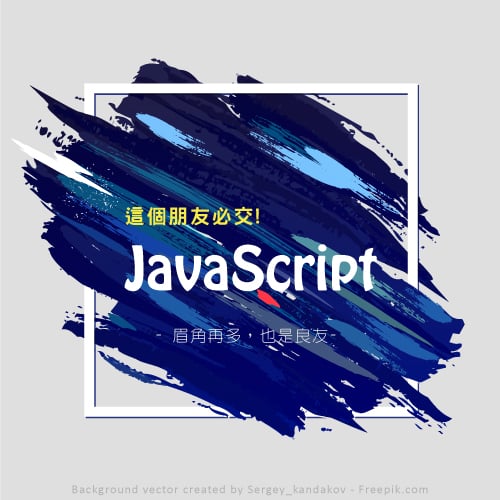This

this 指的是 function 的執行情境,簡單想就是呼叫 function 執行的對象是誰。
主要的 this 對象有以下幾種:
- window 物件
- 一般物件
- DOM 物件
this == window:
一般 function 的 this 對象都是 window,把它想成是預設值就好。ES5 的 function 判斷 this 的時機是 function 執行時的情境。在沒有指定給其他物件去呼叫的情況下,this 都是指向 window。
var env = 'global window';
function showContext(){
var env = 'local scope';
console.log('this == '+ this.env);
}
showContext(); //"this == global window"如上,即使 function 中有宣告一樣的變數名稱,但 this.env 依然會是找全域的變數。 剛開始接觸時,可能會想說"那不然 function 寫在另一個 function 中執行吧,在外層 function 執行的環境中呼叫內層 function,這樣執行環境就會是外層 function 吧?" 會跟我一樣這樣想的話..那就直接試試看吧。
var name = 'global Mary';
function wrapper(){
var name = 'local John';
function sayMyName(){
console.log('My name is '+ this.name);
}
sayMyName();
}
wrapper(); //"My name is global Mary"結果還是導向 global 去了,其實照上面的說法去想的話還滿合理的,首先 function 預設 this 會是全域 window,而 function 執行時如果不是由其他物件呼叫,this 對象不會改變。因此上面的例子中,即使包了一層 function 去執行,但這個內層 function 並沒有被指定給其他物件來用,this 對象當然還是在 window 啦。跟宣告的地方在哪沒有關係,執行情境則是要看呼叫它的物件是誰。
this == obj:
依照上面的方向思考下去,this 是 obj 的時機就很好理解了。
var name = 'global Mary'
var mary = {
name: 'obj mary',
sayMyName: function(){
console.log('My name is '+ this.name)
}
}
mary.sayMyName(); //"My name is obj mary"疑心病發作的我有想過,那是因為 function 寫在物件裡面呀~那 this 對象當然是那個 obj,既然會這樣想,那就寫在外面試試看吧XD
var name = 'global Mary'
var mary = {
name: 'obj mary',
sayMyName: sayName
}
function sayName(){
console.log('My name is '+ this.name);
}
mary.sayMyName(); //"My name is obj mary"結果還是一樣~跟 function 宣告的地點無關~而是在於呼叫它的對象是誰。很重要所以講超過三遍! 但物件的 function (method) 中如果有另外執行其他 function 的話,就要特別注意 this 的使用。假設內層 function 也會用到 this,就需要另外設定 this 的參考,否則又會指定到 window 去了。
var name = 'global Mary'
var mary = {
name: 'obj mary',
sayMyName: function(){
function sayName(){
console.log('My name is '+ this.name);
}
sayName();
}
}
mary.sayMyName(); //"My name is global Mary" <--變成 global Mary
//------要改成以下模式才能正確指回 obj-------------
var name = 'global Mary'
var mary = {
name: 'obj mary',
sayMyName: function(){
var _this = this; //另外設定this的參考來套用
function sayName(){
console.log('My name is '+ _this.name);
}
sayName();
}
}
mary.sayMyName(); //"My name is obj mary"上例的問題在於,雖然最終執行 sayMyName 是由 mary 這個物件呼叫的沒錯,但 function 中的 sayNmae 並非由其他物件呼叫,裡面的 this 就會是預設的 window。因此才會另外設定物件 this 的參考(_this),讓裡面的 function 也能抓到這個物件 this。
this == DOM obj:
第三種情況比較特殊,主要發生在監聽事件上,針對 DOM 物件做監聽時,callback function 的 this 會指向那個 DOM 物件,這時就不是 window 囉!
//假設 html 有個 id 為 a 的 a 連結
var a = document.getElementById('a');
a.addEventListener('click', function(){
console.log(this);
});
//this 會顯示這個 DOM 元素的內容以上就是 ES5 的 this 變心過程,自己最常採到的雷就是 method 中的 this 忘記另外設定,這種在 debug 時如果腦袋運作不流暢還會卡很久..搞到最後才發現是忘記設 this 的參考。
箭頭函式的 this
至於 ES6 的箭頭函式,this 的對象依據就大大不同了!箭頭函式的 this 不會重新綁定對象,而是參考它外層的執行環境中 this 是誰,也就要看它被宣告的位置在哪裡。因此箭頭函式不能作為物件的 method,也不能用做事件監聽的 callback function,不然 this 永遠都是 window。
//物件 method 使用箭頭函式的話
var mary = {
name: 'Mary',
sayMyName: ()=>{
console.log(this.name)
}
}
mary.sayMyName(); //not defined,因為 global 沒有 name 這個變數
//監聽事件使用箭頭函式的話
var a = document.getElementById('a');
a.addEventListener('click', ()=>{
console.log(this);
});
//會抓到 window 而不是 a 這個 DOM 元素跟 ES5 相反,箭頭函式就可以很方便的用在 method 中,不用另外設定 this 參考就可以抓到同樣的 this 對象。
var mary = {
name: 'Mary',
sayMyName: function(){
var sayName = ()=>{
console.log(this.name);
}
sayName();
}
}
mary.sayMyName(); //"Mary"